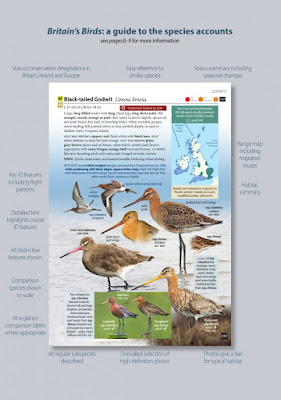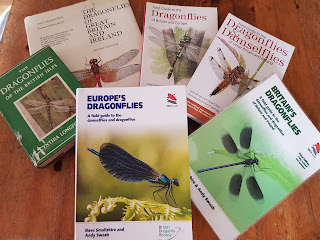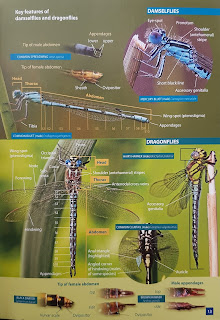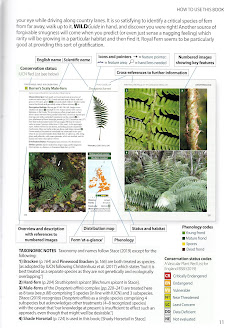 Britain’s Birds. An Identification Guide to the Birds of Great Britain and Ireland. Second Edition, fully revised and updated
Britain’s Birds. An Identification Guide to the Birds of Great Britain and Ireland. Second Edition, fully revised and updated
Rob Hume, Robert Still, Andy Swash, Hugh Harrop & David Tipling
Princeton University Press WILDGuides | 2020
576 pp. | 15 x 21 cm
Paperback | £20 / $ 35 | ISBN: 9780691199795
Despite commencing birding at a time when painted plates in field
guides left quite a lot to be desired, I have been slow to entirely
embrace photographic guides. My first was the
Collins Bird
Guide, “a revolutionary field guide” to the birds of Britain
and Europe, and it provided a welcome additional source of visual
material at a time when good quality photographs of birds were not
readily available, but I certainly never pressed it into action as a
field guide. The first publishers that seemed to be dealing with the
limitations of photographic material in order to take full advantage
of growing photographic libraries were WILDGuides in the UK and Kenn
Kaufmann in the USA. Both were skilfully manipulating selected images
in order to compensate for different light conditions, standardise
postures and eliminate artefacts of the photographic process. Both
publishers now have a long list of titles covering a wide range of
taxonomic groups, some of which have were sorely lacking in
identification literature, and many of these guides are now standard
identification works. However, the United Kingdom’s avifauna is
very well covered by a dizzying number of field guides, some of them
amongst the best guides to any avifauna in the world. A new guide
launched onto this crowded field has to be very good indeed if it is
to make any significant contribution. And
Britain’s Birds,
published in 2016, is, and it has.
I have had the first edition by my
bedside since that time. I typically pick it up at the end of the day
to resolve queries arising from the day’s encounters, and one
consultation generally leads on to another. After 40+ years of birding, I still
get puzzled or excited by something every day, and this book helps me
resolve doubts. It seems fitting that the first author, Rob Hume, has
been a familiar name from YOC/RSPB magazines since I began birding.
Rob’s co-authors together have truly formidable experience, not
only on this topic, but in photography, design and the production of
field guides. So the user is in very safe hands indeed.
Britain’s Birds is a large,
comprehensive field guide, approaching the size of many of the
standard Neotropical guides that cover avifaunas several times as
large. At 1.44 kg and nearly 600 pages, it could be reasonably
argued that this is not a field guide at all – indeed, my first
edition has never seen sun, shower or the shady inside of a backpack
– but then again, British birders of my generation were schooled to
leave all references at home, but rather to take detailed field
notes, something that I dutifully abide by to this day; and indeed,
being of a similar vintage, this is the process suggested by the
authors.For those who feel daunted by such a tome, or really do want a portable guide to take into the field, watch out for my review of the companion
British Birds, A Pocket guide.
Why so large? The authors cover all 631
species on the British and Irish lists as of the end of 2019, using
BOU/IRBC taxonomy which is in turn adopted from the IOC
World
Bird List (note
that, as Nigel Collar has
pointed out, IOC denotes the
“international
ornithological community”, not International Ornithological
Congress). Another 33 species are also covered. So a page per
species is about what one would expect for a visual guide to birds.
 |
| A typical species account |
What about content? All regularly
occurring species are typically treated by a page of coverage which
includes text, photographs and a map. Birds are presented in their
habitat, giving an additional clue to their characteristics. Scarcer
species receive less space, while problematic groups, such as gulls,
enjoy expanded comparative sections. All plumages are included,
depicted with 3,591 photographs.
Maps are derived from current
BirdLife
International base maps, which were originally compiled by
BirdLife International and
Handbook of the Birds of the
World (the latter now defunct). They are a generous size that is
easy on the eye and permits high resolution. Arrows indicate broad
migration routes. Status, seasonality and population data appear
above the map, and habitat information below, allowing the user to
determine almost at a glance the chances that a particular species
has been seen.
Text is concise and, for me, achieves
that tricky balance between providing enough description to clinch
identification and avoiding extraneous detail. The team’s field
experience is much in evidence, with expert insight being employed to
craft succinct accounts that incorporate much distilled
identification knowledge. Capitals, bold text and italics help
navigate the sections.
Any downside? Having written field
guides myself, I have renewed respect for those who take on such a
task, and am now strangely reluctant to pick holes in the work of
others. The production of a work like this is a massive undertaking,
and all field guides contain errors, many of them spotted the day
after the galleys go to press. However, I would be hard pressed to
find much to complain about with this field guide, and remarkably
uncharitable to draw attention to anything I found. I had already
consulted the first edition on a daily basis, and – barring one
unfortunate but conspicuous photo mix-up in my first printing –
errors were few and far between, and the overall utility of the guide
simply swamps any gripes. This edition has corrected the few
oversights I had found and has improved the already high overall
quality in every respect. Doubtless Chris Batty’s role as an identification consultant will have eased the burden of verification (he kindly gave me the benefit of his formidable knowledge on one of my own field guides). As far as field guides to the British
avifauna are concerned, Svensson
et al.’s Collins field
guide and this current volume have, for me, become the two standard
works the I reach for first, and their very different approaches
complement each other nicely. If I need to delve beyond them, I reach
for Witherby, BWP, van Duivendijk, Beaman and Madge, Harris
et al.
or the relevant standard monograph.
Given that I view this as a must-have
for anyone with an interest in identifying the birds of the UK,
whatever their level of expertise, the question then becomes, “Should
owners of the first edition replace it with the second?”. That’s
a hard question to answer, and depends as much on the strength of
one’s bookcase shelves and the tolerance of one’s cohabitants as any
technical factors. The current edition incorporates 800+ new photos,
layout has been improved in key places and the entire production
looks to have been revised with a fine tooth comb. And, of course,
the list of taxa covered is bang up to date, reflecting the February
51st BOURC Report. So American ‘Taiga’ Merlin (
columbarius)
and Shorelark (
alpestris group) are covered, as are other
splits and additions over the past four years.
This
is yet another ground-breaking field guide from the WILDGuides
imprint, and an outstanding guide to Britain's birds for observers of
all levels. At a retail price of £20, this is an absolute bargain.
The authors and all contributors are to be heartily congratulated.
___________________

A typical double-spread species account, in this case for Dunlin
Calidris alpina, showing the major plumages encountered in Britain and Ireland, along with subspecific variation. This is a variable species, and a standard, common 'yardstick' shorebird, so the coverage will be useful for beginners as well as those who want try to determine which subspecies they are seeing. Note the map indicating migration routes, and table showing the months during which different subspecies may be encountered. All relevant information can be taken in at a glance.

The double-spread devoted to the White/Pied Wagtail
Motacilla alba complex has been completely overhauled in this edition. I still find
alba hard to clinch, despite having read and re-read all of the literature, coupled with hours spent staring in monochrome at borderline individuals, so have already interrogated these pages several times. Photographs have been selected to help people like me. Note the inclusion of
personata, new to Britain since the book's first edition.

Ducks in flight: handy double-spread guide to fieldmarks. The images are first class, and the spread has been slightly improved since the first edition, with subtle eye-guiding lines linking images of the same species. Similar comparison spreads are provided for other groups that requite critical flight identification, for example gulls, shorebirds, raptors – even larks.

Particularly tricky identification challenges are sometimes addressed by means of an extra page or two, in this case examining the similar
Apricaria golden plovers. Not quite as much has been made of differences in leg length/proportion and head pattern as I might have suggested, but nevertheless the key identification characters are well covered.




















